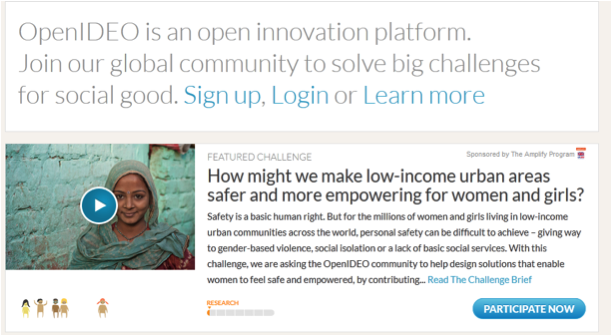NexThought Monday – Collaboration to Save the World: The answer to ‘wicked problems’ like poverty is radical collaboration
Collaboration is becoming the engine of our new emerging economy. Leaders of the private, public, and civil sectors are realizing that they can have inclusive and explosive growth if they create collaborative business models to solve our most intractable problems. Our ability to create collaborative solutions will largely determine whether we live in a world where we are in constant struggle with limited resources, or whether we are thriving in balanced social and environmental systems. But to achieve a high level of collaboration we will need to change the way we manage teams and create solutions.
What’s driving collaboration?
There are a few trends that are driving more intense collaboration. We are more connected to each other because of the reach of technology and social media. This interconnectivity provides more possibilities for collaboration, innovation, and communication in ways that we have not experienced even a generation ago.
In a globalized economy we are facing what I call “wicked problems” – or those problems that are stubbornly difficult to solve because of incomplete knowledge and changing variables, along with complex interdependencies. Like a balloon that you hold in your hands, when you look to contain it and push in an aspect of the problem, then another part of the problem pushes out. Many times what we think are solutions only reveal or create other problems. Collaboration becomes more important to solve these wicked problems around access to education, health care, clean water, and energy resources to an ever-expanding global population.
There is also an increasing complexity gap. According to the IBM CEO Study, 79 percent of CEOs expect more complexity but only 49 percent feel prepared for it, creating a significant gap. Companies find ambiguous complexity more difficult because they are not built to deal with it. They are built for known complexity that requires technical expertise and resources at scale. But confronted with ambiguous complexity – not knowing what you don’t know – the siloed hierarchies that take a planning approach to problem solving becomes inadequate. Collaboration at a large scale is necessary for organizations to confront this complexity
There is also a growing desire to close the loop around our environmental, social, and economic systems. The idea that growth is good and growth can continue indefinitely are the two underlying assumptions of capitalism that can create vicious cycles of scarcity, depletion, and stagnation. What has resulted is exponential growth in negative externalities that are doing damage to our systems. So we must move from exponential curves of vicious cycles, to closing the loop and creating virtuous cycles of shared resources that are replenished and use sustainable systems – which requires collaboration at a massive scale.
Given this complex backdrop, how can organizations look to collaborate in the social sector?

Empower others
Charity Water looks to bring clean and safe drinking water to people in developing countries. Since 2006 it has collected over $100 million for 8,200 projects delivering water to 3.2 million people. What’s amazing is that Charity Water raises 60 percent of its money from grass root donors that they empower to create campaigns with their friends. It’s a great example that shows if you want to have collaboration work at a large scale, you need to empower others.
Use the power of networks
Traditional banking in Africa has had a low penetration rate – a dispersed population over long distances, lack of infrastructure, and lack of financial education make it difficult to get Africans to open bank accounts. M-PESA came in and created the largest mobile money transfer and micropayments service in the world, with close to 25 million subscribers in Kenya and Tanzania. It was originally formed as a collaboration between government agencies, DFID, and Vodafone and Safaricom on the corporate side. It shows that taking a networked approach to collaboration can create completely new models using existing technologies.
Create a space
To foster collaboration you need space, and no organization has created a space for social innovation like the Impact Hub. It provides co-working spaces to social entrepreneurs and I’ve had the chance to work with Impact Hubs in Madrid, Johannesburg, and Oakland, Calif. These have become vibrant communities of collaboration where people meet potential business partners, mentors, and clients.
Get radically transparent
Patagonia has always been at the forefront of radical transparency in the apparel industry. It provides the most information of any firm around its social and environment impact. The power of this transparency is that it promotes more collaboration. In 2011 it was a founding member of the Sustainable Apparel Coalition, which promotes transparency and common sustainability goals in the apparel industry. Since then over 30 of the largest apparel companies have signed on as members.
Ask the right questions
 IDEO.org has always promoted their human design thinking, but has now taken it a step further and now wants to promote active social innovation. Open IDEO is a collaborative platform that brings together a global community to solve big challenges; over the next five years managers will put out 10 challenges, and then provide seed funding and design support for the winning ideas. Those purpose driven questions make the difference in engaging their global communities.
IDEO.org has always promoted their human design thinking, but has now taken it a step further and now wants to promote active social innovation. Open IDEO is a collaborative platform that brings together a global community to solve big challenges; over the next five years managers will put out 10 challenges, and then provide seed funding and design support for the winning ideas. Those purpose driven questions make the difference in engaging their global communities.
What leadership skills do you need to develop in teams?
Reconnect with your purpose
It’s important to be centered around your purpose, and by extension the purpose of your organization. If you can do that, it’s much easier to spot opportunities for collaboration and create a shared vision.
Become a “possiblist”
At the core, social innovation requires you to be a possibilist – to not take the current reality as the only possibility, but to create and manifest new possibilities. At the heart of that process is asking the question – what if?

Seek other perspectives
We need to seek other perspectives in order to help us reframe the problem. That means seeking inspiration from uncommon sources and making connections and parallels to other domains, industries, and disciplines.
Learn to get out of the way
As leaders we need to learn when to get out of the way. For collaboration to be successful we need to remove any barriers to seamless sharing and communication. One of my principal jobs as a leader is to understand what is getting in the way of productive collaboration – including myself.
Explore new forms of currency
To promote new forms of collaboration we will need to create and promote new forms of currency. Already we see new currencies using social capital, skills, and shared resources.
Move from “ego” to “eco”
 Otto Scharmer, a senior lecturer at MIT, talks about the need to move from ego to eco system, a senior lecturer at MIT, talks about the need to move from ego to eco system economies. He believes the root cause of global crises lies within us and our outdated paradigms of economic thought. We will need to question models that call for unabated growth driven by individual gratification, and create new models that promote sustainability and acknowledgement of larger systems at play.
Otto Scharmer, a senior lecturer at MIT, talks about the need to move from ego to eco system, a senior lecturer at MIT, talks about the need to move from ego to eco system economies. He believes the root cause of global crises lies within us and our outdated paradigms of economic thought. We will need to question models that call for unabated growth driven by individual gratification, and create new models that promote sustainability and acknowledgement of larger systems at play.
This will require a new kind of leadership – what we at Emzingo call leadershift. It means shifting leadership from command and control to collaboration and empowerment; from delegation to design; and moving beyond values and giving people voice. By doing so, we can raise our collective consciousness to make sustainable solutions.
Ramon Marmolejos is the executive director and co-founder of Emzingo Group, a hybrid leadership and social development company.
- Categories
- Social Enterprise
